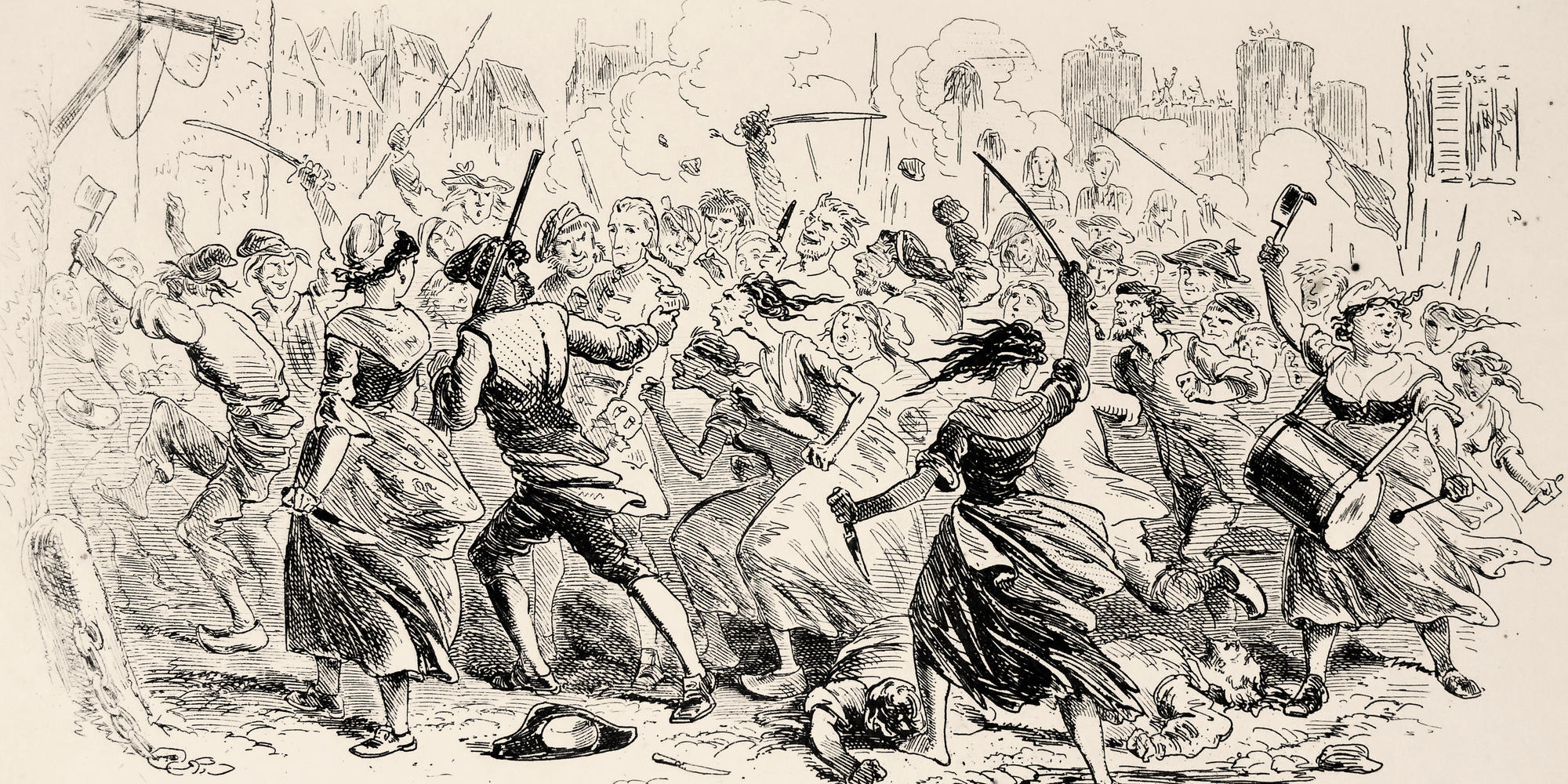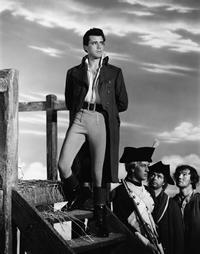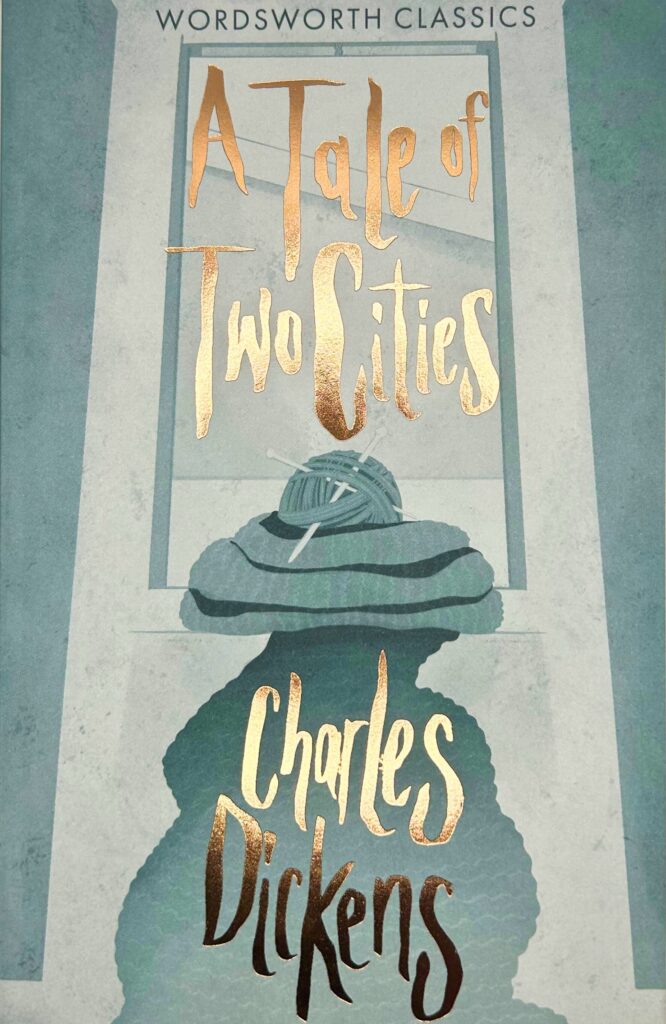
Sally Minogue looks at A Tale of Two Cities
Charles Dickens’ A Tale of Two Cities: a tale of Revolution, alienation, and knitting. Sally Minogue gives some pointers.
‘It was the best of times, it was the worst of times’: one of the most memorable opening sentences of English fiction. Dickens knew how to collar his reader – antithesis, rhythmical balance, punchy monosyllables registering almost before the intriguing proposition designed to pull us in. What are these best and worst of times? Dickens continues, but only in the same generalised polarities, which extend and expand but do not explain:
… it was the age of wisdom, it was the age of foolishness, it was the season of Light, it was the season of Darkness, it was the spring of hope, it was the winter of despair, we had everything before us, we had nothing before us, we were all going direct to Heaven, we were all going direct the other way –
There is no room in this for the reader to disagree, since the narrator has presented us with both sides of the opposition in one sweeping declarative statement. It will be for the novel to fill in the gaps.
A Tale of Two Cities (1859) is one of Dickens’ rare historical novels, his fictional take on the French Revolution, heavily influenced, as he himself acknowledged, by Thomas Carlyle’s The French Revolution: A History (1837). Carlyle’s account – florid, but detailed – had a huge impact on many 19th-century thinkers and writers, including the cool-headed John Stuart Mill, and could be said to be responsible for a zeitgeist view of the Revolution, and specifically of The Terror, in the later 19th century and going into the 20th. It is interesting therefore to see the ways in which Dickens individualises and fictionalises the history. One is his standard way as a novelist, through the creation of the human story of the Manettes, father and daughter, which runs through the whole novel and provides its narrative impetus as the locale shifts between Paris and London. The other is through a series of powerful vignettes. I can attest to their power: it is at least twenty-five years since I read and taught this novel before approaching it again for this blog. My first thought was to seek out the powerful scenes I remembered, interested to see how my memory matched with Dickens’ writing. I think it’s fairest to say that I had an indelible pictorial image in each of these cases without necessarily having a clear linguistic memory; but evidently the vivid detail of the writing had produced that image. In all the cases – most strikingly perhaps in the more abstract and philosophical example which I talk about at the end – the specifics of my memory were accurate. Hats off to Dickens then, given the unreliability of my memory in general.
The first such symbolic scene comes in Chapter 5, The Wine Shop. A cask of wine has fallen in the street as it is manhandled from a cart, its hoops are broken (‘shattered like a walnut-shell’), and wine spills and flows in the filthy thoroughfare. Immediately ‘All the people within reach had suspended their business, or their idleness, to run to the spot and drink wine’. Thus, with superb economy, our author conveys a time of great need. Men get on their knees to scoop up the wine in their hands; nursing mothers soak up the wine in the handkerchiefs pulled from their heads, and squeeze it into their infants’ mouths; others lick and chew on the bits of wine-sodden cask. There is an air of carnival and camaraderie – life has produced a sudden benison, and all can share in it. Then suddenly, Dickens shifts the tone. Carnival turns grotesquely upside-down, Bakhtin-like, and ‘one tall joker … scrawled upon a wall with his finger dipped in muddy wine lees – BLOOD.’ Enter the Revolution:
The time was to come, when that wine too would be spilled on the street-stones, and when the stain of it would be red upon many there.
Dickens slips seamlessly from a realist scene drawn with graphic intensity to a larger social overview:
Samples of a people that had undergone a terrible grinding and re-grinding in the mill … The mill which had worked them down, was the mill that grinds young people old; the children had ancient faces and grave voices; and upon the grown faces, and ploughed into every furrow of age and coming up afresh, was the sign, Hunger.
There follows a brilliant and relentless evocation of the way Hunger invades every aspect of life. Then just as seamlessly, we are led inside the wine-shop where the broken wine cask was being delivered, to meet one of the central characters of the novel, Madame Defarge. We have gone from the detailed realist scene, to the grand-scale symbolic and philosophical account, and back to the small scale again. Mme Defarge, it will turn out, encompasses both these scales herself. A tricoteuse – a knitter – she performs the most feminine and domestic of acts, but also an act of historical record, as she knits into her work the names of the traitors to the Revolution:
It would be easier for the weakest poltroon that lives to erase himself from existence, than to erase one letter of his name or crimes from the knitted register of Madame Defarge.
Another vignette. Here Monseigneur, representative of all the aristocracy of France, is shown in his full glory, a resplendent parallel to those in extreme want:
Yes. It took four men, all four a-blaze with gorgeous decoration, and the Chief of them unable to exist with fewer than two gold watches in his pocket, emulative of the noble and chaste fashion set by Monseigneur, to conduct the happy chocolate to Monseigneur’s lips. One lacquey carried the chocolate-pot into the sacred presence; a second milled and frothed the chocolate with the little instrument he bore for that function; a third, presented the favoured napkin; a fourth (he of the two gold watches) poured the chocolate out.
The impetus of this neat description is in inverse proportion to the triviality of what is described. A few pages later comes an event where the proportions are reversed. The Marquis d’Evrémonde, after leaving Monseigneur’s levée, is being driven in his carriage along the public way. Again, it is a street scene, recalling the previous one of the spilt wine:
With a wild rattle and clatter, and an inhuman abandonment of consideration not easy to be understood in these days, the carriage dashed through the streets and swept round corners, with women screaming before it, and men clutching each other and clutching children out of its way. At last, swooping at a street corner by a fountain, one of its wheels came to a sickening little jolt.
The carriage has killed a child; the Marquis throws a gold coin to compensate, and a coin is thrown back in dissent, bringing out his fury, and his true self: ‘“You dogs!” … “I would ride over any of you very willingly, and exterminate you from the earth.’’’ So cowed are the crowd that they raise no objection. But ‘the woman who stood knitting looked up steadily, and looked the Marquis in the face … the one woman who had stood conspicuous, knitting, still knitted on with the steadfastness of Fate.’ Mme Defarge, apparently ignominious working-class woman, knits the Marquis’ careless murder of a child into her woollen record. Later he will be made to pay.
Thus in these two memorable street incidents, created by Dickens with all his graphic skill, the opposing forces of the Revolution are burnt into our imagination without much of a political word being said. Meanwhile, weaving in and out through the novel is the story of Dr Manette and his daughter Lucie, itself following some of the same political and historical strands. Knitting is more than a metaphor or a device in this novel, it informs the narrative structure itself. The abstruse connection between Manette and the Evrémondes, which is brought full circle as Lucie marries Charles Darnay, descendant of the Evrémondes, is wrought as in a complex pattern, woven and interwoven. It is radical of Dickens to use such a domestic device to carry the major historical forces and events that underpin this novel. Yet in another way, it reminds us that Dickens is a profound devotee of the domestic and the familial. He lays the groundwork most powerfully to remind us of the underlying causes of the Revolution; he even persuades us of those deep beliefs which drive the individual to sacrifice himself or herself in favour of the larger good. Monsieur and Mme Defarge consider their cause, and Monsieur issues the time-worn regret of the socialist: ‘“I do not question all this. But it has lasted a long time, and it is possible … that it may not come, during our lives. … We shall not see the triumph.”’ Mme his wife is made of sterner stuff: ‘“We shall have helped it. … Nothing that we do, is done in vain.”’ In this respect, A Tale of Two Cities is remarkable in putting the revolutionary case. But in the end the novel comes down on the side of the personal rather than the political. Certainly where those two elements are united rather than in opposition, as in Mme Defarge herself, Dickens issues a warning rather than an endorsement.

This final judgement in favour of the comfort of personal relationships rather than the comradeship of class is dramatised in the eponymous Two Cities of the title. In London the (bourgeois) family is a refuge; in Paris, the (aristocratic) family is a hierarchy of power. Dickens allows for and even illuminates brilliantly the failings of the latter; but in the end he is seduced by the former. Lucie and Darnay are restored to conjugal bliss, sanctified in Sydney Carton’s hallucination of vicarious happiness as he places his head on the block. And just as the novel began memorably, so it ends – and for some of us it ends with the desperately good-looking visage of Dirk Bogarde in the 1958 film version uttering the immortal words – ‘“It is a far, far better thing that I do, than I have ever done; it is a far, far better rest I go to, than I have ever known”’. The French Revolution resolved. Mme. Defarge’s quiet revolutionary faith that ‘We shall have helped it … Nothing that we do is done in vain’, is lost in the lunacies of the Terror. But after all, given the great fears that were aroused in England by the Revolution, it is no surprise that Dickens, the supreme Victorian author, should reflect exactly the feelings of his audience.
A final vignette, and one that endears me to Dickens withal the reservations expressed above. Very early in the novel, in the chapter Night Shadows, he stands back from his characters, from the bounds of novel itself, even from himself as writer, and muses thus:
A wonderful fact to reflect upon, that every human creature is constituted to be that profound secret and mystery to every other. A solemn consideration, when I enter a great city by night, that every one of those darkly clustered houses encloses its own secret; that every room in every one of them encloses its own secret; that every beating heart in the hundreds of thousands of breasts there, is, in some of its imaginings, a secret to the heart nearest it! Something of the awfulness, even of Death itself, is referable to this.
Dickens the modernist floats above not just his fictional world but the world itself, and looks into the secret heart of things. Briefly this becomes a tale not of two cities, but of the city, and of the way it accentuates such moments of alienation:
My friend is dead, my neighbour is dead, my love, the darling of my soul, is dead. … In any of the burial-places of this city through which I pass, is there a sleeper more inscrutable than its busy inhabitants are, in their innermost personality, to me, or than I to them?
We could be in an Edward Hopper painting. We could be in a Virginia Woolf novel! A fleeting glimpse of a different Dickens to carry with us in this novel of oppositions, and perhaps into his other novels too.
Main image: “The Sea Rises” by Phiz (H. K Browne) from “A Tale of Two Cities” by Charles Dickens. London: Chapman & Hall, 1859. First edition.
Credit: Impress / Alamy Stock Photo
Small image: Dirk Bogarde in the 1958 film version
Credit: Everett Collection Inc / Alamy Stock Photo
Books associated with this article
